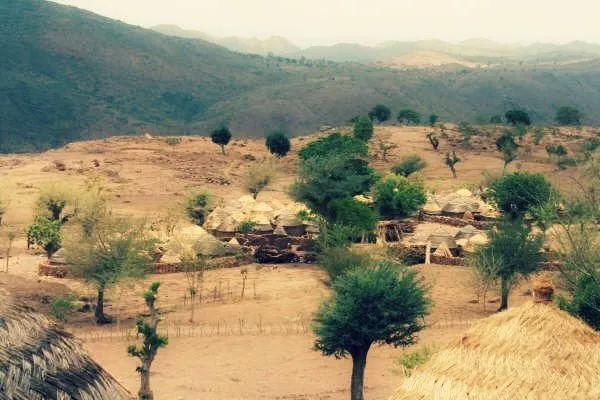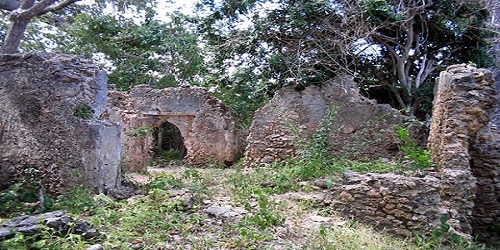Discover Nigeria’s Historic Sites: Oke-Idanre Hill, Surame, Queen Amina’s Wall, and Sukur
Oke-Idanre Hill, also known as Idanre Hill, is a prominent and culturally significant natural formation located in Idanre town, Ondo State, Nigeria. The hill is renowned for its historical, cultural, and natural importance, making it a popular tourist destination.
Key features and aspects of Oke-Idanre Hill include:
- Historical and Cultural Significance: Oke-Idanre Hill holds immense historical and cultural value for the Yoruba people and the residents of Idanre town. The hill is associated with the settlement and founding of Idanre town, and it served as a fortress and a place of refuge during times of conflict.
- Idanre Town: The base of the hill is connected to Idanre town, a community that has preserved its cultural heritage. The town itself has historical landmarks, traditional festivals, and architectural features that showcase the rich Yoruba cultural heritage.
- Natural Landscape: Oke-Idanre Hill is characterized by its stunning natural landscape, including rock formations, lush vegetation, and diverse flora and fauna. The climb to the top of the hill offers breathtaking views of the surrounding countryside.
- Climbing the Hill: Visitors to Oke-Idanre Hill can embark on a climb to the top, where they will encounter ancient relics, structures, and shrines that reflect the historical and spiritual aspects of the hill. The climb itself is an adventure, with well-laid stone steps leading to different levels.
- Owa’s Palace: At the top of Oke-Idanre Hill, visitors can find the Owa’s Palace, which is the traditional ruler’s palace. The palace is a symbol of the historical importance of the hill and its role in the governance and protection of the community.
- UNESCO World Heritage Site: Oke-Idanre Hill is part of the UNESCO World Heritage Site known as the “Idanre Hill Cultural Landscape.” This recognition emphasizes its cultural and natural significance on a global scale.
- Tourist Attraction: Oke-Idanre Hill attracts tourists, researchers, and nature enthusiasts who are interested in exploring its cultural heritage, historical relics, and the panoramic views from the hilltop.

Oke-Idanre Hill stands as a testament to the rich cultural and historical tapestry of the Yoruba people. Its inclusion in the UNESCO World Heritage List ensures its preservation for future generations and promotes its recognition as a site of global significance.
Surame Cultural Landscape: UNESCO World Heritage Site in Sokoto, Nigeria
The Sukur Cultural Landscape, located in Nigeria, is a UNESCO World Heritage Site recognized for its outstanding cultural and natural significance. Situated on the Mandara Mountains in the northeastern part of the country, the landscape encompasses the Sukur settlement, known for its unique architecture, agricultural practices, and cultural traditions.
Key features of the Sukur Cultural Landscape include:

- Terraced Fields: The Sukur people have created an intricate system of terraced fields on the hillsides for agricultural purposes. These terraces not only serve as a practical means for farming but also contribute to the overall aesthetic of the landscape.
- Sukur City: The central point of the landscape is the Sukur city, perched on the hillside. The city is characterized by stone-built structures, including the palace of the Hidi (the local chief). The architecture reflects the Sukur people’s mastery of construction techniques using local materials.
- Cultural Practices: The Sukur Cultural Landscape is deeply connected to the traditions and rituals of the Sukur people. The landscape serves as a backdrop for various cultural practices, including ceremonies, dances, and religious rites. These cultural elements are integral to the identity of the Sukur community.
- Natural Setting: The Mandara Mountains provide a stunning natural setting for the Sukur Cultural Landscape. The combination of the terraced fields, stone structures, and natural elements creates a harmonious and visually striking environment.
- UNESCO Recognition: The Sukur Cultural Landscape was inscribed as a UNESCO World Heritage Site in 1999. UNESCO recognized it for its cultural significance, emphasizing the harmonious coexistence between the Sukur people and their environment.

The Sukur Cultural Landscape stands as a testament to the ingenuity of the Sukur people in adapting to their surroundings while preserving their cultural heritage. It serves as a living example of a traditional African agricultural landscape that has endured for generations.
Surame Cultural Landscape is an ancient archaeological site located in Sokoto State, Nigeria. It represents the remnants of the historic city of Surame, known for its unique planning and architectural features. The site holds cultural, historical, and archaeological significance, reflecting the advanced civilization that once existed in the region.
Key features and aspects of Surame Cultural Landscape include:
- Ancient City of Surame: Surame was an ancient city believed to have been built in the 15th century. It served as the capital of the Kingdom of Kebbi, an influential pre-colonial Hausa state.
- Planning and Architecture: What makes Surame distinctive is its well-planned layout and architectural design. The city was characterized by massive walls and complex structures, including a central palace and other buildings. The planning suggests a high level of organization and engineering skill.
- City Layout: Surame was organized into two main sections: the royal quarters and the commoners’ quarters. The palace complex in the royal quarters was particularly elaborate, with multiple rooms and courtyards. The city had a sophisticated drainage system, indicating a mastery of engineering.
- Palace Complex: The central palace within Surame was a grand structure, showcasing the wealth and influence of the rulers of the Kingdom of Kebbi. The palace featured various rooms, possibly serving different purposes, and was surrounded by defensive walls.
- Decline and Abandonment: While the exact reasons for the decline and abandonment of Surame are not definitively known, it is believed that factors such as external invasions, internal conflicts, or changes in trade routes may have contributed to the city’s decline. The site was eventually abandoned, and nature reclaimed much of the architecture.
- UNESCO World Heritage Site: Surame Cultural Landscape is part of the UNESCO World Heritage Site known as the “Sukur Cultural Landscape.” This recognition underscores its importance in preserving the cultural heritage of Nigeria.
- Tourist Attraction: The site attracts tourists, historians, and archaeologists interested in exploring the ruins of Surame and gaining insights into the architectural and cultural achievements of the people who inhabited the region centuries ago.

Surame Cultural Landscape stands as a testament to the advanced urban planning and architectural prowess of ancient African civilizations. Its recognition by UNESCO highlights its significance in the broader context of world heritage.
Queen Amina’s Wall in Zaria, Nigeria
Queen Amina’s Wall, also known as the Earthen Wall of Zazzau or Zaria Wall, is a historic defensive structure located in the city of Zaria, Nigeria. It is named after Queen Amina, a legendary warrior queen of the Hausa kingdom of Zazzau (Zaria), who is believed to have ordered the construction of the wall during her reign in the 16th century.
Key features and historical aspects of Queen Amina’s Wall include:

- Construction: Queen Amina’s Wall is an ancient earthen defensive wall that was constructed to protect the city of Zazzau from external threats. It is believed to have been built in the late 15th or early 16th century during the reign of Queen Amina.
- Dimensions: The wall is reported to have had an original height of about 40 feet (12 meters) and a width that allowed for the passage of a horse. It surrounded the city and had strategically placed gates.
- Materials: The construction materials used for the wall were primarily earth, with some sections reinforced by wooden structures. The wall was built using traditional techniques, and its construction is often attributed to the skilled engineering and military strategy of Queen Amina.
- Historical Significance: Queen Amina, known for her military prowess and leadership, is a significant figure in Hausa history. The wall is associated with her efforts to fortify the city against invasions and secure the trade routes in the region.
- UNESCO Recognition: While Queen Amina’s Wall is not listed as a separate UNESCO World Heritage Site, it is often mentioned in the context of the Historic Centre of Zaria, which is recognized for its cultural significance. The wall contributes to the historical narrative of the region.
- Tourist Attraction: Queen Amina’s Wall has become a notable tourist attraction, drawing visitors interested in exploring Nigeria’s rich history and cultural heritage. Tourists can observe the remnants of the ancient wall and learn about Queen Amina’s legacy.

Queen Amina’s Wall serves as a tangible reminder of the historical and architectural achievements of the Hausa people and the formidable leadership of Queen Amina in pre-colonial Nigeria.
Sukur Cultural Landscape: UNESCO Site in Sokoto, Nigeria
The Sukur Cultural Landscape, located in Nigeria, is a UNESCO World Heritage Site recognized for its outstanding cultural and natural significance. Situated on the Mandara Mountains in the northeastern part of the country, the landscape encompasses the Sukur settlement, known for its unique architecture, agricultural practices, and cultural traditions.
Key features of the Sukur Cultural Landscape include:

- Terraced Fields: The Sukur people have created an intricate system of terraced fields on the hillsides for agricultural purposes. These terraces not only serve as a practical means for farming but also contribute to the overall aesthetic of the landscape.
- Sukur City: The central point of the landscape is the Sukur city, perched on the hillside. The city is characterized by stone-built structures, including the palace of the Hidi (the local chief). The architecture reflects the Sukur people’s mastery of construction techniques using local materials.
- Cultural Practices: The Sukur Cultural Landscape is deeply connected to the traditions and rituals of the Sukur people. The landscape serves as a backdrop for various cultural practices, including ceremonies, dances, and religious rites. These cultural elements are integral to the identity of the Sukur community.
- Natural Setting: The Mandara Mountains provide a stunning natural setting for the Sukur Cultural Landscape. The combination of the terraced fields, stone structures, and natural elements creates a harmonious and visually striking environment.
- UNESCO Recognition: The Sukur Cultural Landscape was inscribed as a UNESCO World Heritage Site in 1999. UNESCO recognized it for its cultural significance, emphasizing the harmonious coexistence between the Sukur people and their environment.

The Sukur Cultural Landscape stands as a testament to the ingenuity of the Sukur people in adapting to their surroundings while preserving their cultural heritage. It serves as a living example of a traditional African agricultural landscape that has endured for generations.
Related Reading Explore Nigeria’s Natural Wonders: Millennium Park, Ado Awaye, and Ogbunike Caves

